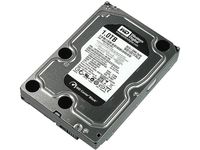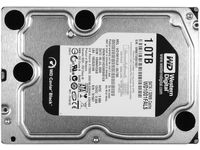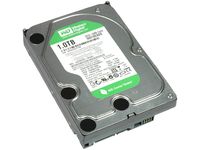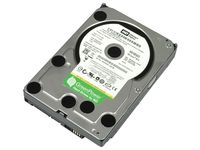Tom’s Winter 2008 Hard Drive Guide
Western Digital: Mainstream and Low Power
Western Digital introduced a new classification for its desktop hard drives only a few months ago. While they are all still Caviar class drives, WD now offers the Caviar Black for enthusiasts, Caviar Blue for the mainstream, and the Caviar Green for higher efficiency. We looked at the latest Caviar Black, the first, and second generation Caviar Green drives, thenconcluded with the RAID Edition 3 drive and Velociraptor drives for enthusiasts and business users.
Caviar Black (WD1001FALS)
The new Caviar Black by Western Digital is the company’s latest upper-mainstream drive, delivering maximum performance and high capacity. This model is called WD1001FALS, and it offers up to one terabyte of capacity at a 7,200 RPM spindle speed, with 32 MB of cache memory, a SATA/300 interface and an impressive five-year warranty. It seems like Seagate has been setting the trend, as the Barracuda family has had this warranty for a while. Caviar Black doesn’t run extremely cool and it is not particularly power efficient, but it performs very well.
The Caviar Black offers one of the shortest access times in the market at only 12.2 ms on average. Idle power is acceptably low at a measured 6.5 W. Only one comparable drive, Hitachi’s Deskstar 7K1000.B, showed a smaller power requirement when idle. The Caviar Black is better than the Deskstar 7K1000.B when it comes to performance per watt for workstation I/O, but the Hitachi drive is superior in streaming read performance per watt due to lower power requirements and faster sequential throughput. The Caviar Black and the similar WD RAID Edition 3 (RE3) drive provide the fastest I/O performance of all 7,200 RPM desktop drives and even keep a nice distance from the other drives.
Low Power: WD10EADS And WD10EACS
If you want to go for a low power drive then there is only one WD drive that we truly recommend: the Caviar Green WD10EADS. This is the latest power efficient drive, and it has been the most efficient green drive we’ve had in our lab, as well as being a good performer. Despite its 5,400 RPM spindle speed we found access time to be almost at the level of 7,200 RPM drives. The same applies to throughput: it almost reaches 100 MB/s, which is more than the first-generation Hitachi Deskstar 7K1000 at 7,200 RPM. The idle power of measured 2.8 W is most impressive—the second place finisher in the benchmark chart requires 4.3 W.
Thanks to its extremely low power requirement, the WD10EADS turned out to be most efficient when it comes to performance per watt for streaming read operations, and it even is second for the workstation I/O performance per watt test, despite performance that cannot match a Caviar Black or a Hitachi Deskstar 7K1000.B. The WD Caviar Green WD10EADS loses in application performance and I/O performance, but it was never designed to dominate these benchmarks anyway.
Get Tom's Hardware's best news and in-depth reviews, straight to your inbox.
We have to advise against getting the first generation Caviar Green drive—the WD10EACS—because the current model WD10EADS is just so much better. The first Caviar Green (known as Caviar GP) only reached 76 MB/s throughput, with rather slow access times and below-average application benchmark and I/O benchmark results. Even when it comes to power savings, its successor beats it with much improved idle and activity power consumption. If you want an efficient drive go for the WD Caviar Green WD10EADS, not the WD10EACS.
Current page: Western Digital: Mainstream and Low Power
Prev Page Seagate: Barracuda 7200.11 Next Page Western Digital: High Performance


